Things to see and do in Bilbao in 1 day
Things to see and do in Bilbao in 1 day
Recommended route through Bilbao. First, a bit of history…
Are you planning a trip to Bilbao in the north of Spain? Are you looking for recommendations for things to do in Bilbao in 1 day? Then you have come to the right place. But before recommending places to visit in this northern city of the Basque Country, we should start with its history and transformation.
The city of Bilbao offers one of the best getaways in Basque Country. It is difficult to find a city that has changed so much in such a short amount of time as did Bilbao. The years of grey that denoted sadness painting the streets of Bilbao have been left behind. That grey began to emerge with the industrialization of the area and did not leave the city until the end of the millennium.
Bilbao is included as one of the stops in some of our road trips in Spain.
Bilbao, the city with the most inhabitants in the Basque Country, has been surpassed by its sister city of San Sebastian in the tourism sector, but that does not take away from what Bilbao has to offer. Today, when one thinks of Bilbao, one thinks of its estuary, the Guggenheim, and its football team, among many other things. Bilbao is a city that began as a villa in the 14th century when Don Diego López de Haro founded the town with the approval of the Castilian king, Ferdinand IV. Since then, Bilvao, as it was written in those times, began to grow in importance thanks to the commercial route to the sea that passed through the city. The port of the city became one of the most important in the Kingdom of Castile.
In this post, we want to take a walk with you to discover things to see in Bilbao and to recommend places where to eat and drink to make your experience in the city a unique one.
Where to stay in Bilbao?
Bilbao is not a very large city and it has underground. We would, however, recommend staying inside the city center or just next to the Ria. Bear in mind that walking from the Guggenheim to Casco Viejo just takes 25 minutes by the Ria (the river) and 35 if you decide to walk crossing the city.
These are our favorite hotels in Bilbao:
Barcelo Nervión. A perfectly located (at half distance from the Guggenheim and Casco Viejo) 4-star hotel that offers a fantastic breakfast and overall good value for money. Modern style
Hotel Gran Bilbao. A very modern hotel with excellent facilities. Not so close to the city center but at an area where street parking is permitted. Bear in mind that street parking is regulated in Bilbao city center
Hesperia Bilbao. As Barcelo Nervion, located at a fantastic location and also very modern facilities and excellent breakfast.
NH Deusto. If you are looking for a very reasonably priced hotel with a good breakfast, very clean and at a good location, this is a good option.
A rural experience in Bilbao? Try hotel Artexe and you will enjoy a bit of traditional basque atmosphere yet not far from Bilbao city center
We begin the recommended route in Bilbao: a cultural walk
Egun On Bilbo! (meaning, “Good morning, Bilbao!” in the Basque language)
Imagine a day of sunshine and blue skies with just one or two clouds to give the sky a touch of white against the blue backdrop. One can always hope, right? We hope that during your next visit to northern Spain, you will be able to stroll through Bilbao in good weather and sunshine. For now, you can imagine it while reading this post.
If you want to be guided by a passionate local guide this tour offers a very affordable way to visit. See tour
Our recommended route through Bilbao begins at the start of the day in the Indautxu neighborhood to have breakfast in one of its many good cafés. Where and what should we have breakfast in Bilbao? There are many options but we will give a few recommendations for having breakfast in Indautxu. For a basic breakfast, we recommend Cafetería Scala on Calle Ercilla where you can enjoy a coffee with one of its typical toasts of butter and sugar. You will also find the typical “bollo de mantequilla” that you will see in every pastry shop in the city. If you prefer a more filling breakfast, we recommend Cafetería Brass in Pozas. You will always find variety, from the already mentioned “bollo de mantequilla” to a pincho of tortilla.
Once you have finished breakfast, you can make your way to the Alhóndiga or Centro Azkuna, a cultural complex named after the legendary mayor of Bilbao. This building, built over 100 years ago to store and commercialize grain, was abandoned once a newer one was built in the neighborhood of Rekalde and was converted into a cultural center. This project was led by the architect, Philippe Starck. Take notice of the 43 columns (each one more striking), the terrace perfect for a mid-afternoon cocktail or wine, and the pool on the last floor which can be seen from the ground floor due to its glass floor. You can also make a stop at its eclectic café to taste its amazing homemade cakes or a pintxo and have a coffee.

We exit the Alhóndiga and head towards the Guggenheim Museum passing through Moyúa. At the intersection of Pozas at the end on the left, you can see the new San Mamés football stadium and if there is a game that day, you will notice it very soon. The entire street fills with football fans having pintxos, beer, and wine.
In the plaza of Moyúa, we can highlight several things. Apart from the garden area of the oval square, two constructions stand out above the rest. One is more traditional as is the Chávarri Palace, today the headquarters of the Delegación del Gobierno in Vizcaya. A prime example of Bilbao architecture of the 19th century, this building stands out for having different designs on all of its windows. The other more modern construction is the metro entrances of the city, commonly called “Fosteritos” after Norman Foster who designed the Bilbao metro.
How to get around Bilbao
Bilbao, although a large city, the truth is that it is very easy to get around as it has a very good public transportation network. The urban buses connect all of the corners of Bilbao. Also, the metro, the tram, and the Euskotren have stops all over the city and connect Bilbao to other municipalities in the area. And if you prefer to walk, Bilbao is very nice for pedestrians, wide avenues, pedestrian streets, and long walkways like that of the estuary.
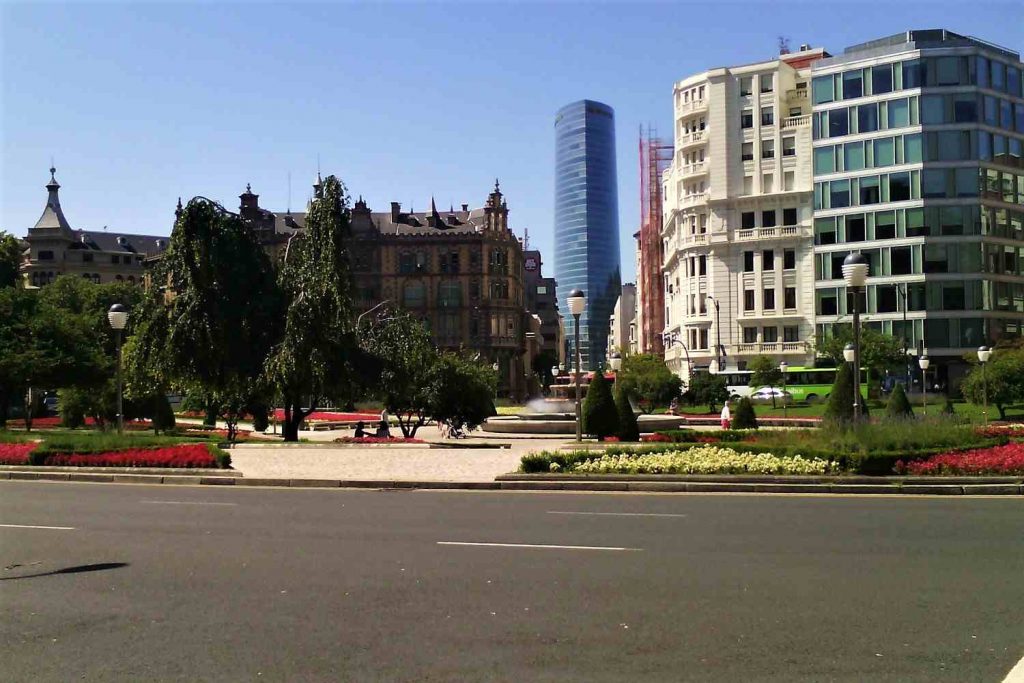
If we continue to the Guggenheim Museum through the Doña Casilda Park, we leave behind the Museum of Fine Arts on our right, one of the best valued of Spain. We arrive at one of the biggest examples of change in Bilbao in recent years, the Guggenheim Museum of Bilbao. The museum was inaugurated in 1997 and is part of the Guggenheim museum network of the world. The building is one of the most interesting modern buildings to see in the city. Its architect, Frank Gehry, made a spectacular project to house contemporary and modern art. The question that many people make is, is it worth entering the Guggenheim museum? We think so because, in addition to the interior architecture, you will always find outstanding works of art. Out of the permanent works, the ones that stand out are “Puppy”, the dog made with colorful flowers that is situated at the entrance of the museum and is the work of Jeff Koons, and Richard Serra’s “La Materia del Tiempo”. Other temporary exhibitions complement the visit. Artists like Picasso, Bacon, Tàpies, or even Yoko Ono have had exhibitions here.
In this link you will find a perfect way to spend a perfect day in Bilbao, visiting the Guggenheim museum and enjoying a fantastic meal at one of Bilbao´s best Asadores (traditional local restaurants)
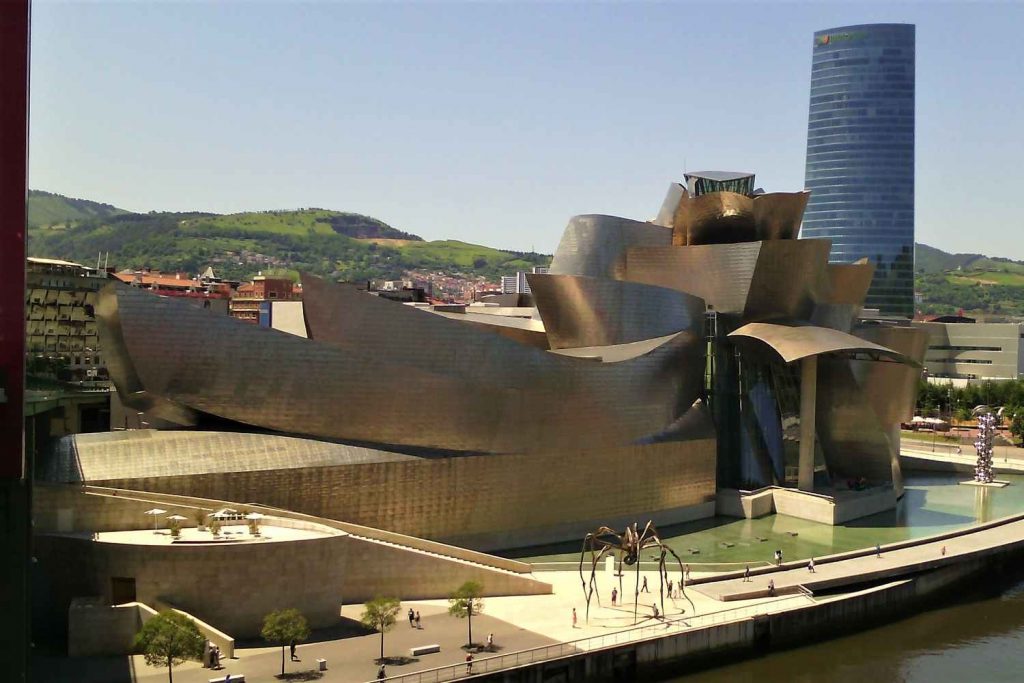
What interesting things are there near the Guggenheim?
If you’re feeling a bit hungry after your museum visit, you can always have a pintxo in the café. The Guggenheim of Bilbao also has a Michelin star restaurant, the Bistró Guggenheim Bilbao. Once we’ve exited the Guggenheim, our route continues along the estuary until we reach the Zubizuri bridge (Calatrava bridge), another example of avant-garde architecture in Bilbao. This bridge has a history worth mentioning. The bridge was designed by the Spanish architect in the 90s and it had a glass floor to be able to see the estuary when crossing it. When the bridge was completed, the city council decided to add an annex to the bridge and created a footbridge that linked the bridge with the Plaza de la Convivencia so as not to have to go down to the estuary to be able to cross it. This upset the Valencian architect who decided to denounce the city council. Months after the bridge had been inaugurated, the architect himself got into trouble after complaints from pedestrians who crossed the bridge on a rainy day (typical weather for Bilbao). They ended up with injuries due to slipping on the wet glass floor of the bridge. The city council decided to cover the glass floor with a rug due to this incident. So today, you cannot see the estuary through the bridge floor but at least you avoid a trip to the hospital.
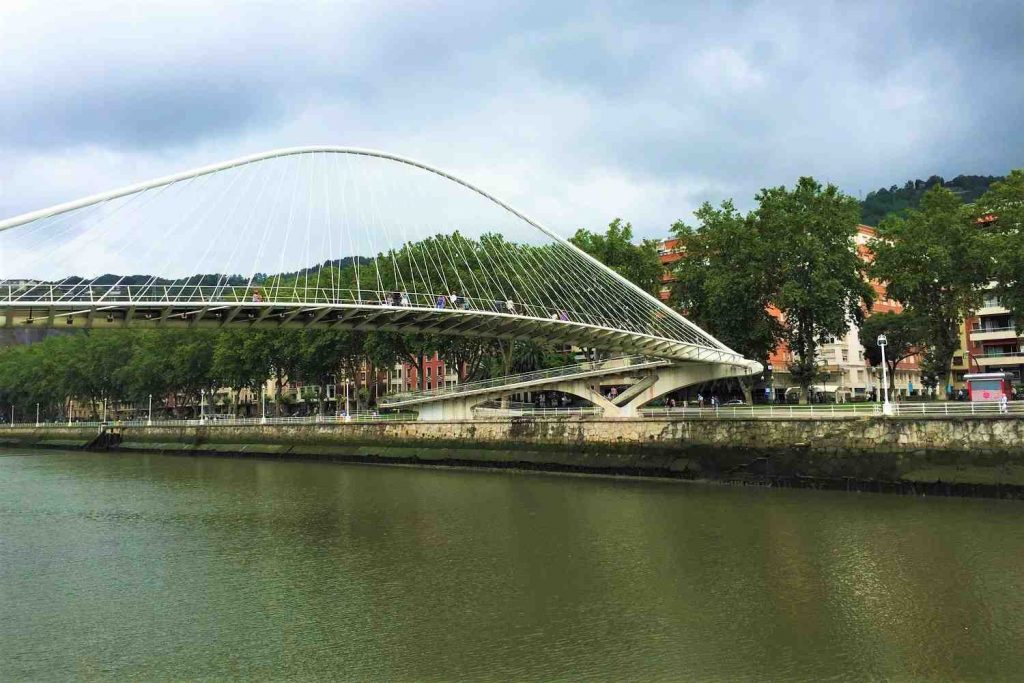
What are the best views of Bilbao?
Crossing the bridge, we can reach the Artxanda funicular. It is in this “cultural section” that we find one of the best views of the city. The city of Bilbao is situated in a sort of trench surrounded by mountains and hills. To the south, the Pagasarri mountain range overlooks Bilbao from up high. To the north, the ascent is somewhat more comfortable as it can be accessed by funicular up to Artxanda from which you can obtain unrivaled views of Bilbao. The grass area invites you to sit and observe the people down below, the planes that land in the city, and the clouds that pass by.
On top of Artxanda, there are two restaurants that we can recommend if you want to eat at a nice restaurant of high quality at one of the highest points of the city. Also, do not hiss the Escultura de la Huella (fingerprint sculpture).
When you´ve returned to the city below, continue along the Nervión estuary until you reach the Ayuntamiento de Bilbao (city hall). On the way, you will see the Barceló Nervión Hotel. After the city hall building and without crossing the estuary, you will see El Arenal, a park that becomes the center of the festivities of the “Semana Grande” (Aste Nagusia) in Bilbao.
Right at the end of the park is the Arriaga Theater, the most distinguished theater of Bilbao and a must-see building. Of neo-classical style, the theatre was built in the 19th century and is dedicated to the Basque composer, Juan de Arriaga. This composer began his success as a musician at a very young age and is called the Basque Mozart. At the early age of 11, he was already composing music and representing them throughout the city.
On the other side of the Nervión estuary is one of the most beautiful train stations in Spain and perhaps in Europe, the Abando Station. It was designed by the English railway engineer, Charles Blacker Vignoles, who also designed the railway lines between Bilbao and Tudela.
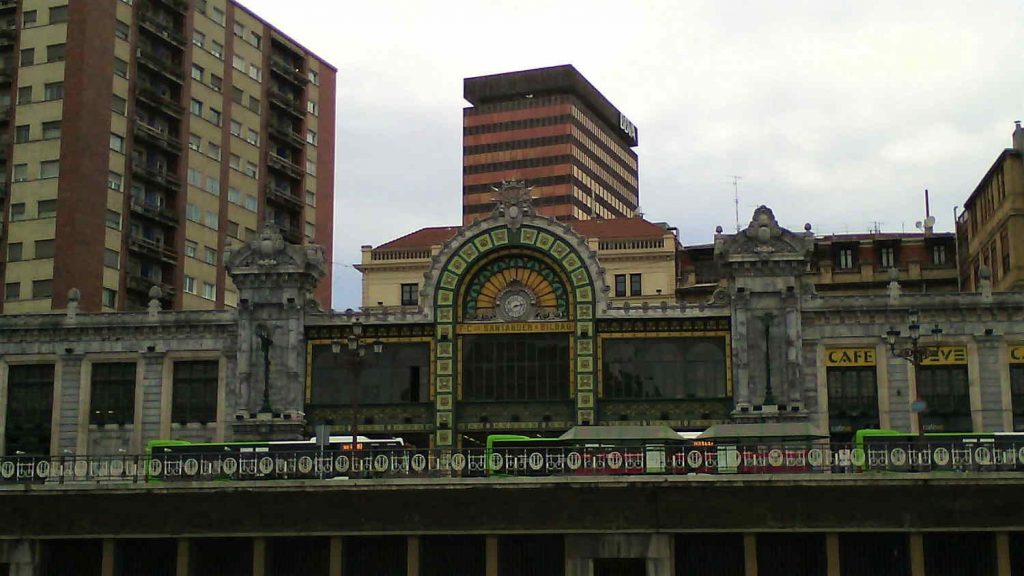
Entering the old town of the city we can discover a completely different Bilbao. The streets are narrow surrounding the Cathedral of Santiago where they come out in all directions and end on the banks of the Nervion estuary or another street. This area is known as “Zazpi Kaleak” (the seven streets in Basque) because back in the day this neighborhood only had seven streets to be able to move around the area. Later on, more streets were opened that now complete the “Casco Viejo” of Bilbao as it is known today. All of these narrow streets are full of life thanks to its typical establishments where groups of friends move around every day for drinks and food in the area.
From the center of the city, we can highlight the gothic-style Cathedral dedicated to the patron saint of the city, Santiago. The cathedral was mostly built during the 14th and 15thcenturies and some elements are from the Renaissance such as the side arches of Done Jalue street. Walking close to the cathedral can be somewhat claustrophobic as its high walls contrast with the narrow alleys that surround it.
Another sight of the old town is the Plaza Nueva (Barria Plaza). Built in the 19th century, this neo-classical square is a place where people meet every weekend before going out for drinks and tapas in the old town. The Acadamy of the Basque Language, the Euskaltzaindia, is located on the north façade of the interior of the square.
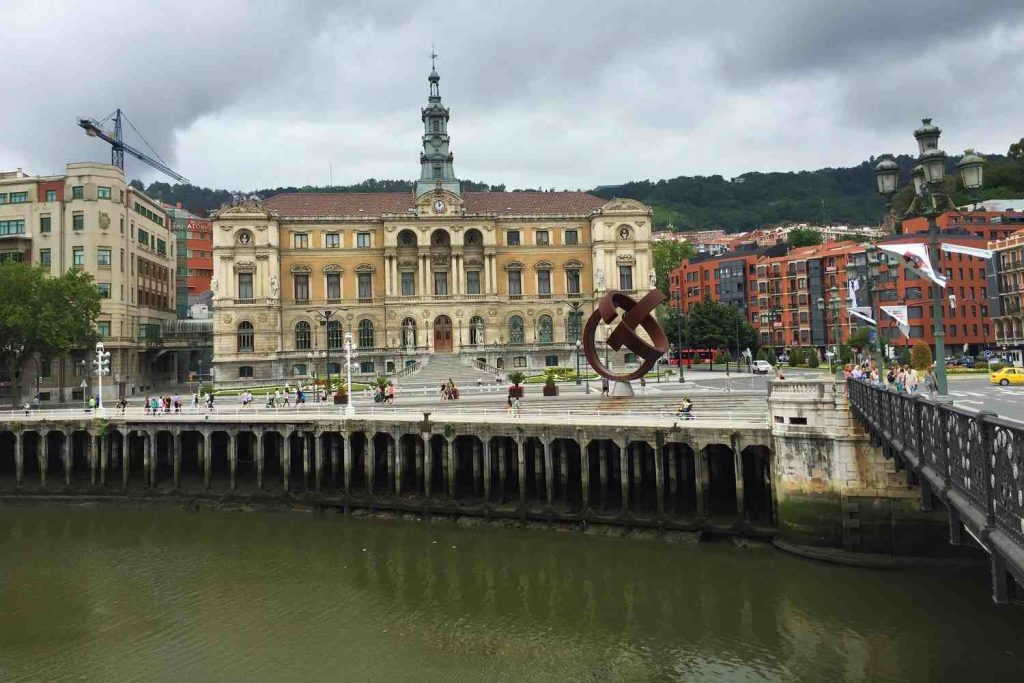
Right on the south side of the old town close to the Bilbao estuary, we recommend visiting the Mercado de la Ribera. The market combines traditional market shopping with new stands that offer already prepared and cooked products for you to enjoy gastronomy at the moment without having to prepare it yourself.
Where to eat in Bilbao?
A tradition in every corner of Basque Country – the “Pintxo-Pote”. It consists of a pincho and drink usually at a fairly acceptable price. This is offered in different neighborhoods on different days. If you are able to enter a place, congratulations, and if not, you can try at the next place. It´s the funny thing about these nights. If you are in Bilbao when there is no Pintxo-Pote, create it yourself by going to different bars with friends or family.
Bilbao is known for having high-quality pintxos and this can be discovered in every bar, café, and restaurant. Here we will give a few examples, but that does not mean that you cannot go to many more as there is great variety and great quality all over Bilbao.
If you start in the Pozas area, you can start at a cheese bar, Gaztandegi Berria. If you like cheese, this is the cheese paradise of Bilbao. They offer different pintxos of cheeses from every part of Spain and Europe including, of course, the most characteristic cheeses from northern Spain. There are two locations, one on Calle Indautxu and the other on Calle García Rivero Maisuaen.
Another place we can recommend in Pozas is Ziripot. This pintxos bar offers quality in its products and a carefree atmosphere. Both the bar and the terrace are ideal places to enjoy a glass of good wine and a pintxo.
Changing areas, we can go to one of the most legendary places in Bilbao, Café Iruña. Here they serve one of the best (if not the best) “pinchos morunos” (meat skewers) of the city. It is always crowded but you can try to find a spot around the enormous bar that turns around the whole place. Its neo-Mudejar décor gives it a special charm and not only for its pintxos. Colorful mosaics depicting sherry wines surround the bar of this restaurant that has turned 114 years old.
Another classic of the city is the Café La Granja in the Plaza Circular next to the Abando metro station.
In the old town (Casco Viejo) we can recommend several places to eat good pintxos and we can start with a place that prepares some of the best mushrooms of the city, El Motrikes. This small bar and carefree bar prepares grilled mushrooms that are spicy and very tasty. It is difficult not to find this place crowded with people doing “pintxo-pote” with their drink of choice, a zurito, wine, or kalimotxo.
Con B de Bilbao is a restaurant that offers very high-quality pintxos in the center of the old town. You can´t miss it.
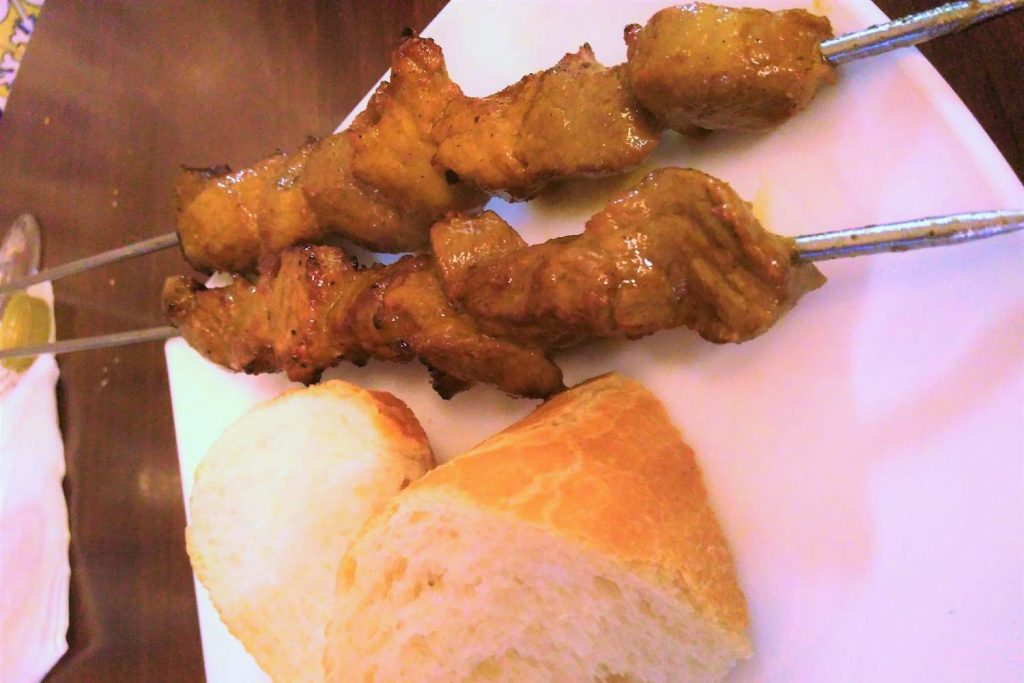
In the area of Plaza Nueva, we can recommend Bar Charly with its most traditional pintxos or Gure-Toki with a selection of pintxos and tapas that are more innovative and avant-garde. Whichever you go for, you will have made the right choice.
If you are in the mood for something more filling than pintxos, we recommend Restaurante Rio-Oja. They offer delicious “cazuelitas” (small casseroles) such as squid in its ink, stuffed peppers or, the Basque classic, cod pil-pil.
Sweet pintxos? It is true that some bars and restaurants offer them but today we will not recommend any, as Bilbao is also known for its delicious pastries. You will notice dozens of pastry shops within your first hour in the city and the variety of options is great. We can recommend trying the typical pastries of Bilbao such as “las Carolinas”, “pastel de arroz”, “pastel ruso”, “pantxineta” or “las persianas”. And if ice cream or nougat is more your thing, don’t leave Bilbao without visiting the Turronería Adelia Ivañez in the old town.
Typical pintxos from Bilbao:
Gilda
Bonito Picante
Tortilla
Rabas
Pincho Moruno
Bacalao
Pimientos rellenos
Mojojones (mussels) – Tigres/Rellenos
Txangurro
Txaka

What to do during Aste Nagusia? A week to see the authentic Bilbao
It goes without saying that local festivals are a great time to learn more about the culture, traditions, gastronomy, and festivities of a city. Feasts in Spain are always a great experience and Bilbao’s are not an exception. Aste Nagusia, “the big week” in Basque, is the local feast of Bilbao. It is celebrated the last two weekends of August beginning on a Friday and ending on the Saturday of the following week. During the feast, there are concerts, competitions of typical dishes, Basque sports, fireworks, parades, lots of food and lots of parties. The queen of the party is Marijaia, the traditional mascot of the festival.
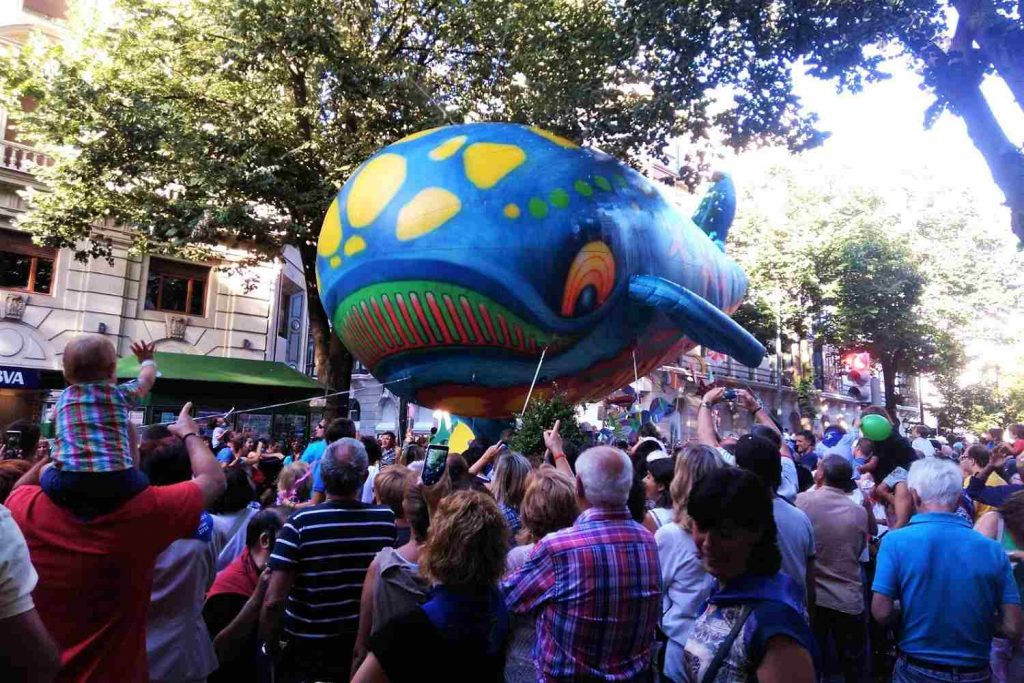
What to see on the “outskirts” of Bilbao?
Bilbao has incredible places and monuments worth visiting not so far from the city. We give you a few ideas for places to visit during your stay in Bilbao. If you stay extra days in Bilbao and wish to combine your stay there with a nearby location, we can recommend these getaways near Bilbao.
A very good option is to enjoy for wine lovers is to enjoy a wine tasting tour in Rioja from Bilbao.
Perhaps one of the most famous symbols of the city and one of the most interesting things to see near Bilbao (although not strictly in it) is the suspension bridge that crosses the estuary of the Nervión from Portugalete to Getxo, north of Bilbao. The bridge was erected in the 19th century to connect these two towns without hindering the route of boats from the Cantabrian Sea to the port of Bilbao. It was inaugurated in July of 1893. The designer was Alberto Palacio and the engineer who carried out the project was the Frenchman, Ferdinand Joseph Ardonin.
The Vizcaya Bridge, as it is officially called, is now a symbol of the engineering of the Industrial Revolution and Bilbao. It is not uncommon to see visitors reaching the bridge to cross it by foot or by ferry.
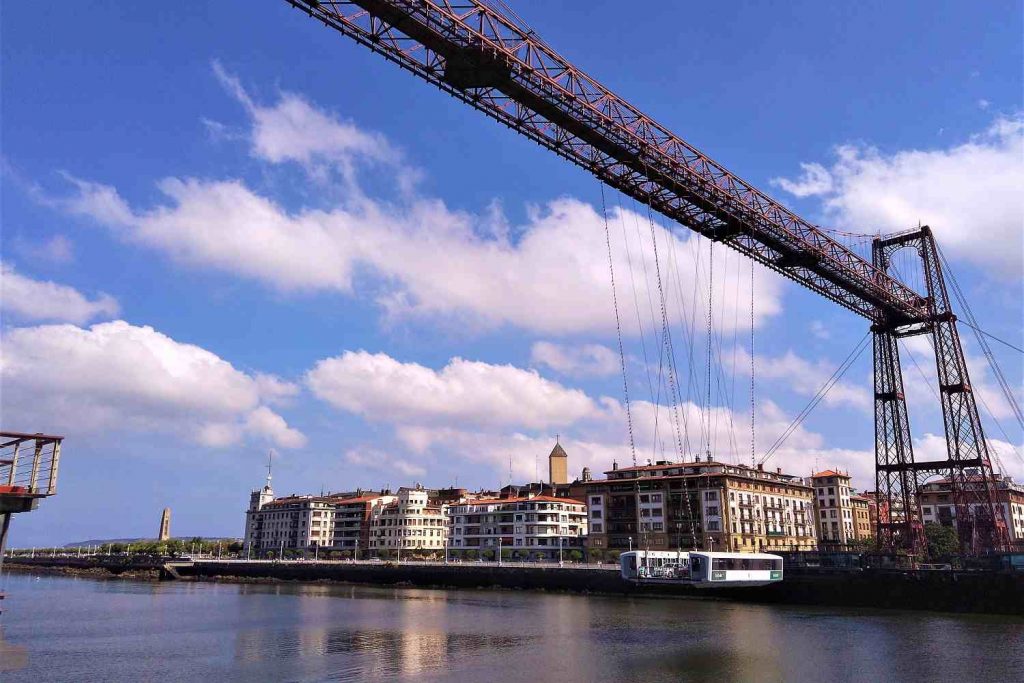
Another must-see on the outskirts of Bilbao is San Juan de Gaztelugatxe. This hermitage built on top of an island in the Cantabrian Sea attracts thousands of visitors each year. Visitors must climb more than 240 steps to reach the final destination of the hermitage of San Juan dating back to the 10th century. To reach the hermitage, you need to walk a couple of kilometers downhill that you will have to go up again. The views along the way are spectacular. From Bilbao, you can take public transportation to Bermeo, which is the locality in which San Juan de Gaztelugatxe is located.
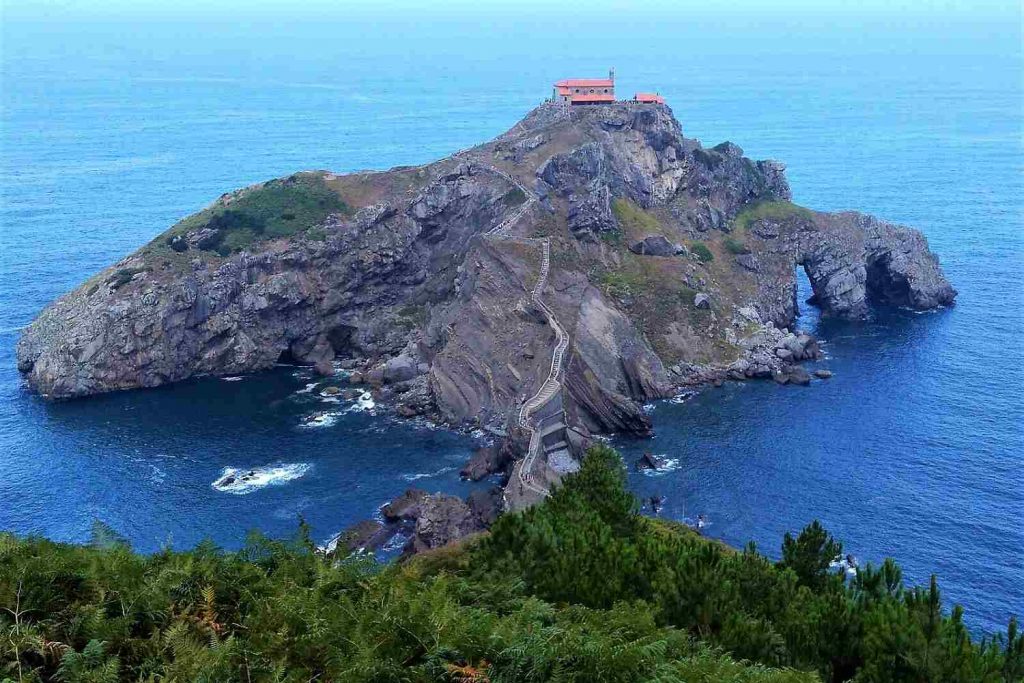
As you can probably tell by now, Bilbao is a city that is full of energy and vitality, where gastronomy is a fundamental pillar in the life of a “bilbaíno” and with an avant-garde architecture that puts Bilbao on the map of modernity. Easy to reach and well-connected, this city has been increasing in the number of international tourists who are attracted to it by its museums, streets, and people. And after this cultural, gastronomic, and historical tour of Bilbao, now you are the one who decides what to see, what to visit, and when to visit Bilbao. What we are sure of is that you will not be disappointed.
Agur!
The Glossary:
El Glosario: (essential for a getaway in Bilbao or to better understand what to do in Bilbao)
More information about Bilbao on the website of the city
Botxo: This term refers to Bilbao, a city enclosed between mountains as if it were at the bottom of a trench
Pintxo: Usually refers to a slice of bread with some food on top of it.
Pintxo-Pote: Combination of a pintxo and a drink.
Hamaiketako: A snack around mid-morning (at 11 am)
Gabarra: The “gabarra” is a typical boat in the port areas for loading and unloading goods. In Bilbao, they are also used for celebrating the football titles of its team, Athletic de Bilbao.
Fosterito: This is the name given to the entrances of the metro of Bilbao built by British architect Norman Foster.
Bollo de Mantequilla: Typical sweet from Bilbao. It is a type of sugared brioche filled with buttercream.
Carolina: Another typical sweet from Bilbao. It is a merengue over puff pastry with chocolate and egg yolk.
Pastel de arroz: Another sweet from Bilbao. It is a small pastry with rice being one of the main ingredients.
Pantxineta: Typical Basque sweet of puff pastry with cream and chocolate.
Pastel Vasco: Basque pastry with puff pastry and cream.
Kuadrilla: A “kuadrilla” is a group of friends that usually meet in a designated area to go out for “poteo” (drinks and pintxos).
Talo: Another typical snack from Bilbao and the Basque Country. It is a corn-bread tortilla with grilled chorizo. Very typical during the Santo Tomás feast in December.
Txaka: Mixture of chopped crab meat with hard-boiled egg and mayonnaise. Used in a multitude of different pintxos.
Mojojones: This is what they call mussels in Bilbao. They are seen in different pintxos as “tigres” (spicy), steamed, and stuffed.
Marijaia: Fictional character representing the feasts of Bilbao. At the end of the “Aste Nagusia”, the Marijaia is burned to signify the end of the feasts for the year.
List of the best buildings in Bilbao (names in Spanish)
Centro Azkuna
Museo Guggenheim
Torre Iberdrola
Palacio Chávarri
Estadio San Mamés
Catedral de Santiago
Basílica de Begoña
Teatro Arriaga
Teatro Campos Eliseos
Palacio Diputación Foral de Vizcaya
Estación de Abando
Biblioteca Central de Bilbao
Real Academia de la Lengua Vasca
Ayuntamiento de Bilbao
Mercado de la Ribera
We hope that you have enjoyed these ideas of things to see and do in Bilbao.
is proudly powered by WordPress
